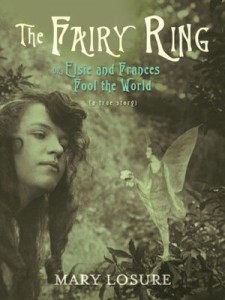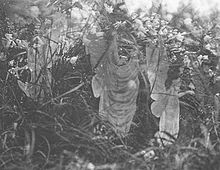

When Frances Griffith arrived in England with her family in the winter of 1917, the place didn’t seem like home. Though English by birth, she had grown up in sunny South Africa and the Yorkshire district was a gloomy contrast. When she picked up a handful of snow and immediately dropped it because it was cold, her parents laughed. But her cousin Elsie Wright, with whom Frances would be staying while her father went away to war, was warm and friendly, even though Elsie was 15 to Frances’ 9. And there were other compensations, like the wild Yorkshire landscape with its steep little valleys and rivers. The beck (stream) behind her aunt and uncle’s house was a particular refuge for Frances: “She liked to catch frogs and study their bulging eyes. She liked to see their tiny throats going in and out and to feel their pointy fingers on her palm before they leaped away.” Nature seemed more alive there, which may help explain what happened the day she saw the willow leaf twirling all by itself, with no wind. As she looked, she began to see the leaf twirling in the hand of a little man, about 18 inches high, dressed in green. “He had a rugged face like the workingmen at the railway station who drove carts pulled by huge, beautiful workhorses. He wore a serious expression, as though he had a job to do.”
In further visits she saw other little men, going about their mysterious business. She spent so much time at the beck that her mother demanded to know why, and Frances blurted out, “I go up to see the fairies!” The grownups didn’t buy it of course, and Uncle Arthur’s teasing became so obnoxious that Elsie devised a solution. A gifted artist, she drew and colored some Rackham-ish fairies on paper, cut them out and stuck them on hat pins. Then she borrowed her father’s camera and took a picture of Frances admiring her artwork in the glen. Uncle Arthur suspected a trick, but Aunt Polly half-believed. It was Polly who let the word out, and word got all the way to London’s Theosophist Society and a certain Mr. Edward Garner, who was rather obsessive on the subject of small winged creatures.
Thus began the legend of the Cottingley Fairies, which soon got out of hand and fooled no less a luminary than Sir Arthur Conan Doyle. Sherlock Holmes would have logically eviscerated the girls, but Doyle had been dabbling in spiritualism, especially after the death of his son in the War, and happened to be a soft touch. Before Frances and Elsie knew it, they were in too deep, and saw no alternative but to bluff it out. That meant producing more photographs, most of which look obviously faked to our sophisticated eyes, though the 

True stories like this demonstrate that there’s no bar to gullibility, even in an age that prided itself on hard-headed materialism. G. K. Chesterton, who must have heard of the Cottingley Fairies, wrote in another context, “Fallacies do not cease to be fallacies when they become fashions.” At that time, on the London stage, Peter Pan was begging audiences to save Tinker Bell’s life by clapping their hands if they believed. Some really did believe, but in a few years public interest faded. Elsie and Frances were never publicly exposed. Much later they admitted to faking all the photos except the last, but Frances always insisted she’d seen the little men. Coincidentally, in 1997 two feature films about the Cottingley hoax were released: Photographing Fairies and Fairy Tale: A True Story–proving that fallacies become fashions over and over.
Tomorrow, Lord willing, I’ll post a Saturday review of three contemporary fairy tales. In the meantime, here are some discussion questions on the Cottingley phenomenon: Was there any harm in Frances’s believing she saw the little men? Any chance she did see them? What do we say when people accuse us of believing in “fantasies”? Given our belief that “principalities and powers” exist outside our knowledge, how do we judge between visions?
- Worldview/Moral value: 3.5 out of 5
- Literary Value: 4 out of 5
Stay Up to Date!
Get the information you need to make wise choices about books for your children and teens.
Our weekly newsletter includes our latest reviews, related links from around the web, a featured book list, book trivia, and more. We never sell your information. You may unsubscribe at any time.
Support our writers and help keep Redeemed Reader ad-free by joining the Redeemed Reader Fellowship.
Stay Up to Date!
Get the information you need to make wise choices about books for your children and teens.
Our weekly newsletter includes our latest reviews, related links from around the web, a featured book list, book trivia, and more. We never sell your information. You may unsubscribe at any time.
FREE Bible Guide!
Get a guide to the Best Bibles for Children and Teens. Perfect for an Easter gift.
We'd love to hear from you!
Our comments are now limited to our members (both Silver and Golden Key). Members, you just need to log in with your normal log-in credentials!
Not a member yet? You can join the Silver Key ($2.99/month) for a free 2-week trial. Cancel at any time. Find out more about membership here.
1 Comments
Leave a Comment
You must be logged in to post a comment.


Janie, thank you for the interesting post. I’ve always loved fairy stories, but I tend to be leery of anything suggesting fairies are real . . . it seems to be something accepted in the New Age type movement, and I believe that a fascination with real fairies can be unhealthy, especially for young children.